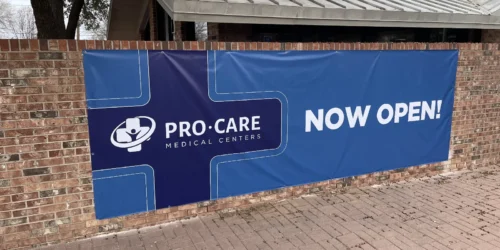If you are feeling an intense amount of pain when you breathe, you may be suffering a punctured lung. This condition is also called pneumothorax, from pneumo, which means related to the lungs, and thorax, which refers to the chest. Some people may refer to it as a collapsed lung.
Air can collect in the space between your lungs and the wall of your chest. When this happens, that extra air can cause pressure to push back on the outside of your lung. As a result, the lung can collapse.
A punctured lung, or collapsed lung, can be a complete collapse, or it can affect just one portion of the lung.
Symptoms of a Punctured Lung
The symptoms of a punctured lung mainly affect your breathing. However, lack of oxygen can cause other issues within the body as well. If you are suffering from punctured lung symptoms, you may be experiencing the following:
- Sudden, sharp pain in the chest, which increases or worsens when you take a deep breath, cough, or otherwise make a sudden move requiring air
- Shortness of breath – you may have to remind yourself to take deep breaths, you may feel winded doing things that are otherwise easy for you, and you may have trouble doing things that require a lot of air, such as singing
- Tightness in the chest
- Fatigue – you may find yourself getting tired much more quickly than usual
- Rapid heart rate – if you have something with a heart rate tracker, such as a smartwatch, it can help alert you to a rapid heart rate. The average heart rate for adults ranges from 60 to 100 beats per minute.
- Bluish tinge to the skin – this symptom is a result of a lack of oxygen.
Types of Punctured Lung
A punctured lung is categorized in three major ways, and the categorization helps explain potential causes. These causes are not definitive, but they can be helpful for you to understand the nature of your condition.
Traumatic Pneumothorax
This form of punctured lung occurs during direct trauma to the chest. Trauma can be anything from a gunshot or a broken rib sustained during a car accident. This is the form of a punctured lung that might inspire you to seek medical help from professionals who specialize in trauma care, such as Pro-Care Car Accident Doctors. There are also certain medical procedures that require pneumothorax for successful medical support. This deliberate form of pneumothorax also qualifies as traumatic pneumothorax.
Primary Spontaneous Pneumothorax
This form of punctured lung is the most difficult to determine a cause for. It can happen without any apparent precedent, and there is no specific cause to point to. As the name suggests, it can happen spontaneously. The most common way by which this form of punctured lung occurs is when a small air sac on the outside of the lung raptures, causing a leak into the cavity around the lung, between your lung and chest wall.
Secondary Spontaneous Pneumothorax
Like the above-mentioned primary spontaneous pneumothorax, this form of punctured lung can seem to appear out of nowhere. However, this type of punctured lung usually occurs as a side effect of a pre-existing lung disease. Some diseases that can result in collapsed or punctured lung symptoms can include lung cancer, asthma, or chronic obstructive pulmonary disease, known as COPD. It has also been identified as a concerning complication of COVID-19, occurring in as many as one in one hundred COVID-19 patients.
Tension Pneumothorax
This is one of the rarest but most life-threatening forms of lung collapse. Positive pressure is defined as pressure that is greater than the pressure in the environment surrounding it. In the case of pneumothorax, air gets trapped in the pleural cavity. The pleural cavity is the space between the two pleurae, or sections, of a lung.
Other Causes
Damaged lung tissue is much more likely to collapse than healthy tissue. Damage to the lungs can happen as a result of the diseases mentioned above, as well as cystic lung diseases, in which round air sacs form within the tissue. Lung damage is also a common result of smoking. Smoking also damages the small air sacs (also known as alveoli) in your lungs, making them more prone to collapse. Smoking is also the main cause of lung cancer cases, which frequently results in secondary spontaneous pneumothorax.
Some people experience diseases that require them to use mechanical tools to aid in their breathing. As a result, mechanical ventilation, such as those used frequently with COVID-19 patients, especially at the beginning of the pandemic, can cause pneumothorax. This occurs because ventilators may create imbalances within the lung and chest cavity which lead to air pressure collapsing the lung.
Risk Factors
The chances of sustaining a punctured lung may increase depending on certain factors about who you are, what your lifestyle is like, and your health history. There may also be some effect that comes from your genetic heritage. The risk factors increasing the likelihood of experiencing pneumothorax depend on the form of pneumothorax.
You may recall that primary spontaneous pneumothorax is the form of a punctured lung that can occur for seemingly no reason. You may be likely to experience this form of punctured lung if you are a smoker. People who are otherwise healthy but have a tall, thin body type are also more at risk for this kind of collapsed lung. Pregnancy is another risk. Although it can be treated in pregnant women, the chance of punctured lung symptoms recurring is anywhere between thirty to forty percent, with an increased likelihood during labor.
Marfan syndrome is a connective tissue disorder passed down through families, which can affect your heart, eyes, blood vessels, and skeleton. Pneumothorax is a common issue for people with this diagnosis.
Epidemiology
Young adults ranging in age from twenty to thirty are the most common sufferers of primary spontaneous pneumothorax. Men are more likely to experience punctured lungs of this nature, with the incidence rate in the United States being 7 per 100,00 men versus 1 per 100,00 women. Recurrence of symptoms for this form of punctured lung usually occurs within the first year after it is first diagnosed, with that recurrence rate at its highest during the first thirty days after diagnosis.
Secondary spontaneous pneumothorax, on the other hand, is more common among older adults, especially in the sixty to sixty-five age range. Men are still more likely to experience this form of the disorder, with an incidence rate of 6.3 per 100,000 men in the United States, compared to 2 per 100,000 women. Smokers are at risk more than any other population, with a risk one hundred and two times higher than non-smokers.
Traumatic pneumothorax, which is the form of punctured lung that occurs as a result of trauma to the chest area, occurs in one-fifth of victims of major trauma. The incidence rate for this form of punctured lung symptoms is 81 per 100,000 people of any gender, such that 20% of patients in a trauma care center may experience it.
Diagnosis
Pneumothorax is relatively easy for medical professionals to diagnose. Your doctor will most likely begin by using a stethoscope to listen to your breathing. If a punctured lung is the problem, then the doctor will hear breathing that is either greatly decreased or nonexistent. The doctor will then run a series of tests. The first among these tests will most likely be an x-ray of the chest to determine whether there is, in fact, air in the cavity between the lung or lungs and chest wall.
The doctor may also administer an arterial blood gas test, or ABG. This test measures the level of oxygen and carbon dioxide present in the blood. This test helps the doctor understand why you may have a hard time breathing. When your breathing is limited due to a punctured lung or a collapsed lung, there will be less oxygen and more carbon dioxide in your blood. This test is fairly quick, with results ready within fifteen or fewer minutes. Of course, this test alone is not enough to make a diagnosis, but it will give your doctor important information towards a complete and confident diagnosis.
In some cases, x-ray and arterial blood gas testing are not enough for your doctor to be completely sure that you are experiencing a punctured lung. In these cases, your doctor may order more detailed imaging, such as an ultrasound or a computerized tomography (CT) scan.
Treatment
The most important first step, and in fact the most important goal, is relieving any pressure on your lung. The pressure is what prevents your lung from fully expanding, thus causing the lack of oxygen reaching your blood. Your medical team may also administer treatment with the express purpose of reducing the likelihood of recurrence. Options for treatment are listed below.
Observation
Small pneumothoraces sometimes repair themselves. In these cases, your doctor may choose observation as the best course of treatment. This will consist of x-ray monitoring and returns to your pulmonary specialist, who will look for signs of the excess air being reabsorbed. It may be several weeks before your lungs can fully expand on their own again.
Aspiration
This form of treatment is most common when there is a large portion of collapsed lung. This method uses either a needle or a chest tube to remove the excess air from the cavity surrounding your lung.
In the case of needle aspiration, your doctor will insert a hollow needle with a small tube, or catheter, in between the ribs. When it is in the cavity creating the pressure on your lungs, the needle is removed. A syringe is attached to the catheter so that the air can be pulled out. The doctor may leave the catheter in so that the lung can fully expand and in order to avoid recurrence of the pneumothorax.
For chest tube insertion, a flexible tube is inserted into that air-filled cavity. It will be attached to a valve that continuously and carefully allows air to exit through the tube. As with a needle, this could take several hours, and your doctor will look for signs of recurrence.
Surgery
Sometimes, especially in the case of frequent recurrence, you may need surgery in order to address the way in which the air continues to leak into the cavity. This surgery is done by using a tiny camera to make a series of small incisions. The incisions are to help the doctor find the area of the lung that is causing the leak so that it can be closed off.
Less Invasive Treatment
There are some nonsurgical forms of treatment that may be appropriate, depending on the severity of your punctured lung. For example, your doctor may administer a substance that will inflame the lung tissue such that the tissues stick together and seal leaks.
Another nonsurgical option is to use a thin tube through your bronchial area (known as a bronchoscope). This tube will help the doctor look into your lungs and air passages. The tube can also be used to place a valve into your throat, which will help the lung expand.
Recovery
Like any injury, the amount of time it will take you to fully recover will depend on a number of varying factors. However, if you are otherwise healthy, treat the problem quickly, and follow your doctor’s prescribed aftercare plan, your lung will most likely be fully healed in six to eight weeks. To ensure that recovery is swift, make sure to take all medication as prescribed, participate in light activity with lots of rest, avoid smoking or sudden changes in air pressure such as during a flight, and practice breathing exercises.
Outlook
While some cases of punctured lung can be deadly if not treated right away, most people with this condition survive, especially if it is treated quickly. However, a major complication with pneumothorax is the increased likelihood of recurrence. Recurrence is especially likely if your punctured lung is the result of trauma to the chest, such as in the case of a car accident or if you are a smoker.
References



